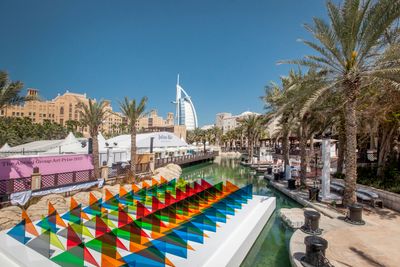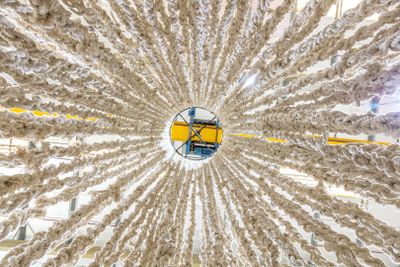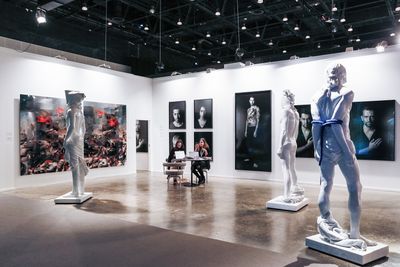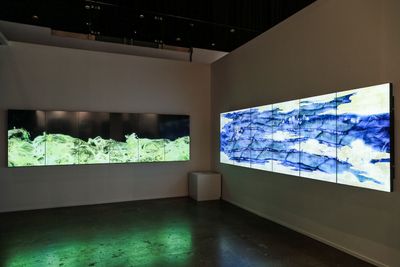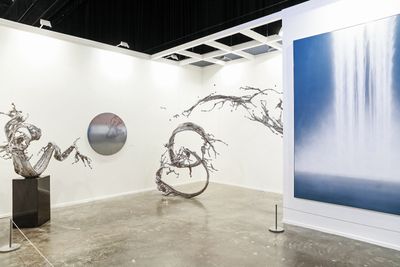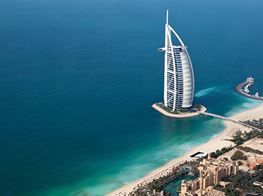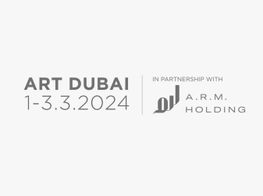All in one place: Art Dubai 2017
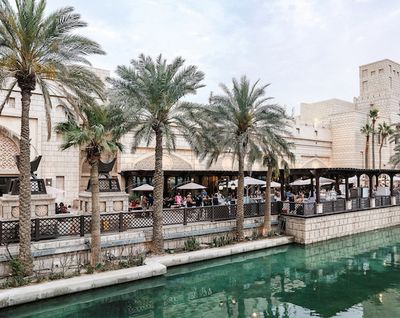
Art Dubai (15–18 March 2017). © Ocula. Photo: Charles Roussel.
This year's edition of Art Dubai (15–18 March 2017)—the most global to date with 94 galleries from 43 countries—was a game changer. At least, that's what it felt like in the Abraaj Group lounge on Thursday night, when top Abraaj Group executives sang Don McLean's 'American Pie' on a small stage with resident Art Dubai enigma, Barry, on the piano, as participants in the art world's economy joined in. With the Global Art Forum 11 tent visible across the water, the moment felt fleetingly poignant, if not like a neoliberal family wedding. The Forum, which focused on trade and globalism in material and historical terms, was criticised at one point for over quoting Karl Marx, making McLean's lyrics about Lenin reading Marx as a quartet practiced in a park seem eerily apt. They were sung in a private lounge a canal away from where conversations about globalisation's histories had earlier unfolded, after all, as neoliberalism's agents and discontents came together through song (or Barry).
Indeed, with the Abraaj Group Art Prize exhibition located only steps away, curated on the dialectic of ritual and seepage by Omar Berrada and featuring shortlisted artists Sarah Abu Abdallah, Raha Raissnia, Doa Aly and winner Rana Begum, a strange reality was seeping out from the ritual of the art fair itself. Once viewed as a bastion of capitalism, it seems these have become safe spaces for cross-global interactions in a time when borders are hardening—a space where people are united by a brand of expansive globalisation that has fallen into disrepute, while singing songs that, well, everyone seems to know: like Kool & The Gang's 'Celebration'.
This global brand defined the halls of 'the world's most globally diverse art fair' this year, just as it did at the Global Art Forum 11 tent over the bridge, in which conversations sought to complexify the map by following infrastructure routes rather than borders. Tellingly, the 'Marker' sector at Art Dubai did not make an appearance, given that, as new director Myrna Ayad noted, the need to offer a platform to underrepresented regions was diminished thanks to the representation that exists among participating galleries this year (27 of which, from Algeria to Uruguay, were participating for the first time). The result was more space for galleries to spread out in the halls of the Madinat Jumeirah, with what international director Pablo Del Val called 'more tightly curated exhibitions' of single, double, or group shows.
Of the group presentations, the most show-stopping of them all had to be by Tehran-based Dastan's Basement, who staged the interior of an artist's studio in their booth as curated by artist Fereydoun Ave. Works by artists including Amin Montazeri, Bahareh Navabi, Nima Zaare Nahandi, and Mamali Shafahi filled every conceivable surface, with books and prints stacked on a work table over which a mixed-media sculpture by Mohammad Hossein Gholamzadeh of an Icarus-type figure wearing paper was hung. (Titled The Fall, it was the centrepiece of the installation.)
Other strong presentations included Green Art Gallery's grouping, which included paintings by Kamrooz Aram, sculptures by Nazgol Ansarinia, Chaouki Choukini's ornate wooden forms, and drawings by Seher Shah. Sfeir Semler's large booth included pieces by Haig Aivazian, Yto Barrada, Etel Adnan and Timo Nasseri, while Imane Fares showed works by Basma Alsharif, Ali Cherri, Mohssin Harraki, Joseph Kosuth, and Younes Rahmoun. Carbon 12's playful selection of works brought a light but considered touch, combining pieces by Bernhard Buhmann, Gil Heitor Cortesao, Amba Sayal-Bennett and Monika Grabuschnigg—the latter two artists presenting a series of geometric, talismanic studies in ink candy colours on paper, and weapons cast in earthenware and arranged into totems, respectively.
Jeddah-based Athr Gallery offered an exciting overview of regional talent. These included four puzzles created from family photos by Sarah Abu Abdallah, as part of the series 'Sanabises' (2017); two vintage poster interventions by Ayman Yossri Daydban—12 (Alawantagiah) and 8 (Wadaan Ela Alabad) from the series 'Posters' (2016)—as well as a set of neon lights by the artist (Inshallah Klh Haytsalah and Sa'at Rooh (An Hour of Soul)), both 2016; Dana Awartani's visual interpretation of the Arabic alphabet in Abjad Hawaz (2016); Ahmed Mater's collection of wooden slide viewers complete with mini slide scenes inside, including Crash, Old Poet, and Television (all 2015); Muhannad Shono's video installation and drawings Children of Yam (2016); and Monira Al Qadiri's three-dimensional printed drill bits from 2016, titled Spectrum I.
Galerie Daniel Templon, meanwhile, presented a global group, with works by Omar BA, Franz Ackerman, Jitish Kallat, and Anju Dodiya, whose well-represented body of work included a series of acrylic and gouache interventions on biblical book pages, including The Beginning (2016), for which Dodiya transformed a dragon's head into that of what looks like a young Dracula. Such global encounters were also palpable in double presentations offered by a number of galleries, including the pairing of Zineb Sedira's photography of ship graveyards with Otto Piene's monochrome surfaces at Plutschow Gallery, and the combination of works by Ibrahim El-Salahi (including the magnificent large pen and ink on paper work Flamenco Dancers (2012)) coupled with Oliver Marsden's radiating, monochromatic circles on canvas at Vigo Gallery.
With more space and considered curation, there were moments of curious visual crossover, as when the architectural drawings by Yazid Oulab at Selma Feriani faced off with those by Rathin Barman presented on the outside wall of Experimenter. Or when the installation of the opulent acrylic, ink and collage on canvas depiction of Madame Tussaud's Cellar (2015-16) by Ramin and Rokni Haerizadeh, and Hesam Rahmanian at Isabelle Van Den Eynde (also showing pieces by Hassan Sharif, who was remembered in an exhibition at the Julius Baer Lounge curated by Cristiana de Marchi) opposed acrylic on canvas paintings of bedrooms by Rana Samara at Zawyeh Gallery, from the 'Intimate Spaces' series.
Other moments of overlap included Diana Al Hadid's crowd-pleasing presentation at Oslo-based Galeri Bandstrup's booth, which included Blind Bust II (2013), a bronze and painted stainless steel sculpture of a bust on a plinth made to look as if the entire thing had been caught mid-disintegration, which was complemented by smaller works shown at Marianne Boesky alongside pieces by Serge Alain Nitegeka, Claudia Wieser, Donald Moffett, and Frank Stella; or the showing of Reza Aramesh's large-scale marble kouroi with their heads covered and their arms tied behind their backs in blue rope at Leila Heller Gallery, which were echoed in the busts located at Ab-Anbar's booth alongside drawings by Sirak Melkonian.
Of the solo exhibitions, Meem Gallery stood out with tapestries by Dia Azzawi, and Gypsum Gallery dedicated their booth to paintings by Ahmed Morsi, whose impressive retrospective is currently being shown at the Sharjah Art Museum. Nicene Kossentini offered understated geometric studies on paper at Sabrina Amrani Gallery, and Marie-Laure Fleisch showcased sculptural and two-dimensional pieces by Santiago Reyes Villaveces. Pace Art + Technology, Ikkan Art Gallery, and Martin Browne Contemporary collaborated to present the immersive digital work of Japanese 'ultra-technologists' teamLab.
Placing tongues firmly in cheek were Thukral and Tagra, who shone at Chatterjee & Lal with a series of playful, kind-on-the-eye acid pop-canvases, as well as a series of blocks made from shredded INR 500 notes in coloured cement 2017, titled Reverentia (2017), and Bread, Circuses (2017)—an inkjet print on butter paper roll with the phrases including 'We constantly repeat ourselves' stamped on them. This booth faced a series of excellent works by Nikita Alexeev showing on Iragui's outside wall, in which the artist created a series of watercolours on paper offering ways to fish various philosophers from the water with bait, from Baudrillard to Plato.
Playful yet political swipes like these seem to acknowledge a shared complicity that feels ever more present in art fairs these days, characterised by the double politics of playing the game while rejecting it. On the fact that some Gulf Labor members have been banned from entering the UAE, for example, one gallerist claimed allegiance to their position while also conceding that business is business, and people do what they have to do. By way of example, Seoul's Artside Gallery made a savvy business choice by presenting 42 cute-as-hell ceramic donuts by Kim Jae Yong on a wall, selling them for USD 900 a piece. (On the penultimate day, only a few remained.)
The Modern section, the only fair sector showcasing museum-worthy works of modern art from the MENASA region, held its fourth edition at the Mina A'Salam next door to the Madinat Jumeirah. (This year's gastronomical event—the remarkable 12-course feast titled Cooking for Liberty, which included a dish called 'The Instant Charm of the Bourgeoisie'—was also staged here in a location known as 'The Room' by the Lebanese collective Atfal Ahdath.) For the first time, the Modern sector staged a symposium as part of its programme, which included speakers such as art historian Iftikhar Dadi and writer and researcher Kristine Khouri.
Modern opened with a beautiful pairing at India's DAG Modern, bringing together the spiritual geometry of GR Santosh, who created a visual language to express his ideas on Shaivite philosophy (a branch of Indian philosophy that follows Shiva), together with the metaphysical abstraction of Biren De. This was followed by Cairo's Arttalks, which showed a powerful selection of pieces by Mamdouh Ammar and Mohamed Ghaleb Khater, the latter artist—characterised by oil and charcoal on canvas or wood panel works depicting bodies and forms against off-white backgrounds—showing in a joint partnership with its neighbouring booth Hafez Gallery, who highlighted figurative drawings and sculptures by Abdel Hady El Wechahi.
Other booths of note included Wadi Finan Gallery's focus on the geometrically inclined figures of Ahmad Nawash's canvases; Gallery One's tribute to Palestinian artist Sliman Mansour, whose work has consistently reflected on and responded to the Palestinian struggle; the focus on Nigerian modernism through the minimalist animal sculptures (and studies) of Ben Osawe, and the landscapes and interiors depicted in the paintings of Muraina Oyelami at Tafeta; as well as the double showcase of works by Anwar Jalal Shemza and Zahoor ul Akhlaq at Jhaveri Contemporary, creating a beautiful encounter between the organic geometries of Shemza and the colour fields of Zahoor, both of whom were born in India, migrated to Pakistan, and studied in England, albeit decades apart.
Moving between both sections of the fair was curator Yasmina Reggad's Art Dubai Commissions, which focused on performance art, and presented interventions by Manuel Pelmuş, Lana Fahmi, Eglé Budvytyte, and Ivan Argote and Pauline Bastard, the latter pair staging a 'Born to Collect' competition, including such figures as Alain Servais, and hosted by Argote and Delfina Foundation's Aaron Cezar. Other performances included Fahmi's What Modernity? [working title], in which performers enacted movements and spoke phrases as they moved through the Modern section; Pelmuş' Private Collection, which presented live enactments of art works whose location are unknown; and Budvytytė's Soft Voice, Harsh Melody, which included seven songs related to, among other things, 'trade', 'the impossibility of ownership', and 'storage'.
Of the songs Budvytytė performed, the first was about the future, and included the line: 'imagine the art fair as a place of radical fermentation'. This notion of the art fair as a space of radical fermentation brings me back to where this report started—at the Abraaj Group lounge on a Thursday night, when Barry the pianist was singing songs everyone knew, including one that Don McClean wrote as an ambiguous reflection on the state of America as he saw it, in which a dream had died.
Fast-forward to Art Dubai in March 2017, in a world that feels more divided than ever, and McClean's lyrics came to haunt a lounge sponsored by a global investment firm located in a global art fair, where people from all parts and all walks were sipping wine and beer (the days of champagne all but over), singing: '... there we were all in one place. A generation lost in space.' And what a space it was. —[O]

